If you’re reading this, it means that you aren’t getting the results you want from your Linkedin outreach.
You might have the perfect list of prospects (which has been ultra-refined,) but your reply rate isn’t great.
Cue the facepalm and frustration, you might be wondering what the problem is?
Often founders and sales teams don’t always realize that the problem lies with their Linkedin messages.
Yes, you might be using personalization, but to what extent? Or could it be that you’re sounding way too salesy?
In this article, we will share some of our copywriting hacks for Linkedin outreach, along with some simple templates that you use when trying to reach out to potential customers.
(Thinking of partnering up with Salesbread to get 20 + qualified leads per month? Read this article to see how we differ from every other lead generation agency out there: https://salesbread.com/the-best-done-for-you-lead-generation-service/ )
Building the perfect list of prospects
(If you feel that your prospect list is perfect, skip this part.)
We aren’t going to delve in too deeply about list building in this article, because its main focus is copywriting.
But we need to stress the importance of having an ultra-defined list before you begin with your Linkedin outreach messages.
Why?
Because if your list isn’t perfect, you’re going to be reaching out to a lot of people who:
A.) Don’t need what you’re selling
B.) Don’t have the budget or purchasing power for what you’re selling.
So even if your message is perfect, people aren’t going to reply because they are a wrong fit for your product/service.
Don’t be fooled by other agencies who promise to reach out to thousands of prospects on Linkedin, because this just means that they aren’t truly defining your target audience.
There is no point in sending our 3000 cold outreach messages, but then only getting 10 qualified leads.
This is how Salesbread is different.
We really obsess about list building and we refine your ideal target list until it is perfect. In fact, this process takes us an entire week before we even begin with the Linkedin outreach campaign.
It’s our job is to analyze your current customers using 34 business attributes and “signals” so that we can detect “Buying Patterns” and uncover your “Look-A-Like” customers that, based on data, will need what you are selling.
We have seen many other businesses target too broadly and this is why companies aren’t getting the results that they would like.
You can’t just say that you would like to target all the CFOs and finance VPs in the health care space.
You need to dig deeper.
This broad targeting introduces too much risk. You have to dig deeper and ask questions like:
A.) What kind of health care company? (e.g. Health Insurance? Hospital or Clinic? Non-Profit)
B.) What’s the size of the company? (250 beds+? Top 300 University-affiliated hospitals in the U.S.? 5,000 employees? 40 Billion in Annual Revenue?)
C.) What services do they offer? (Outpatient? Emergency?)
D.) What’s their location? (U.S. and Europe? 350 miles from Newark, NJ?)
E.) What departments/employees do they currently have/not have on payroll? (Marketing, Social Media, CNO?)
This specific detail will help you figure out who your ideal buying customer is.
Read this article on our approach to list building: https://salesbread.com/b2b-list-building-service/
Let’s dive into the copywriting part…
Step 1: Research is critical for cold messages because it helps you personalize the messages.
Remember how we mentioned earlier that you shouldn’t have a list of thousands of prospects? There’s another good reason for this.
Personalization can be the make-or-break method that will get your prospects to reply to you.
How can you personalize a message if you haven’t researched the prospect? (And if you have thousands of random prospects, research is going to be really time-consuming.)
Before you even begin to send your first message, have a look at the prospect’s Linkedin profile.
Have a look at the example below:
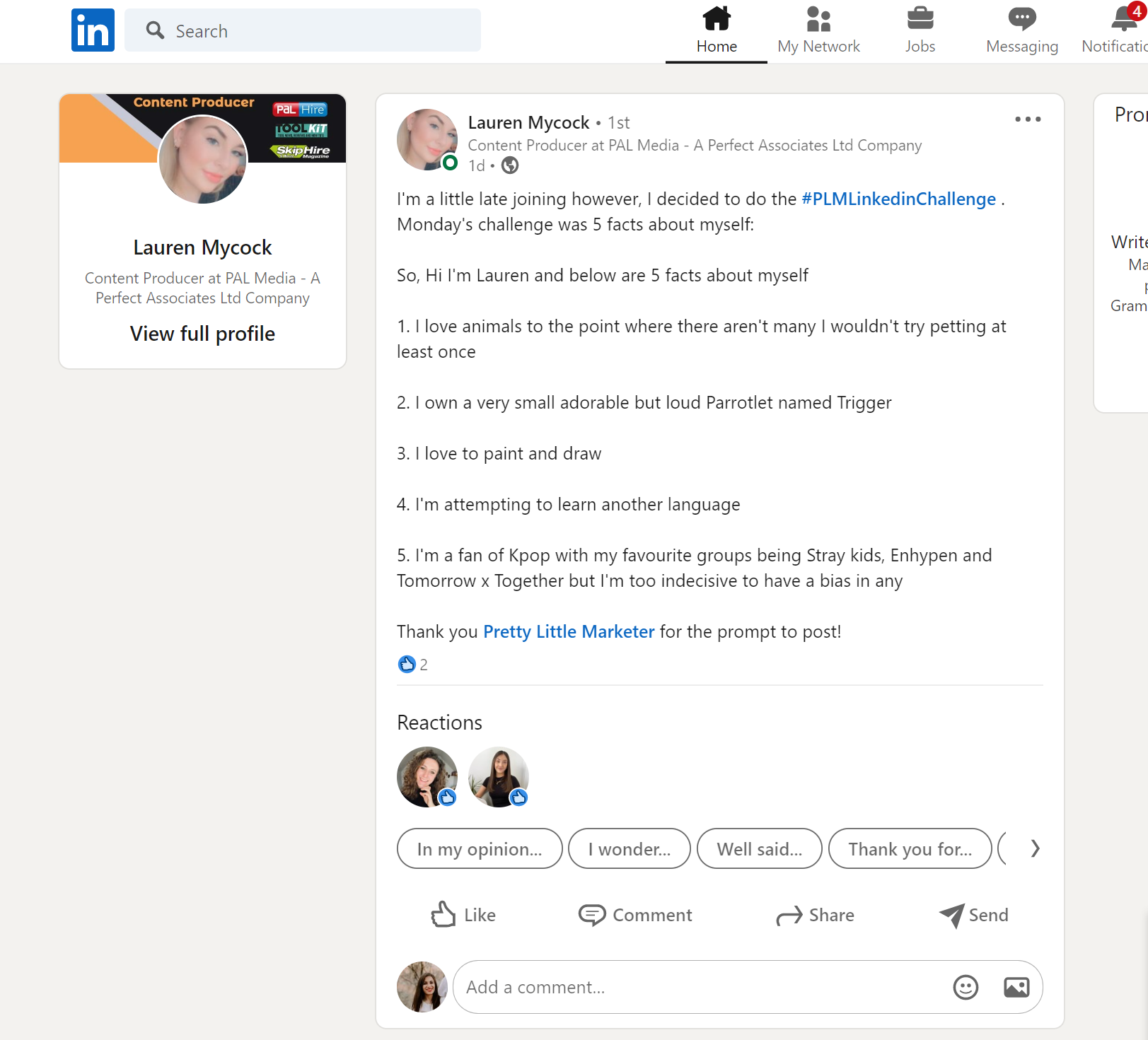
This content creator recently posted 5 facts about herself. This post is a special gold nugget.
Why?
Because it can help you think about what to write to capture her attention. She offers so much information about herself and her interests.
If you didn’t research the prospect, you wouldn’t have this information,
How would you know what to ask them, what to compliment them on, or what commonalities to mention that you both share?
If you don’t use personalization you aren’t going to capture the reader’s attention. And personalization is so much more than just using their first name.
Yes, research takes time.
But this is what separates the generic template style messaging that doesn’t get results, from the expertly personalized messaging that does.
Below is an example of a recent message that I received on Linkedin. The first one I ignored because I could see it was just an automated sales pitch, whereas the second one I actually replied to.
Example 1: No personalization
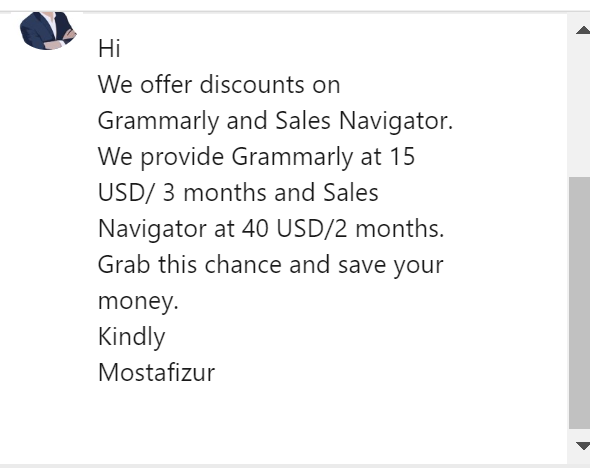
Example 2: A personalized message with a compliment
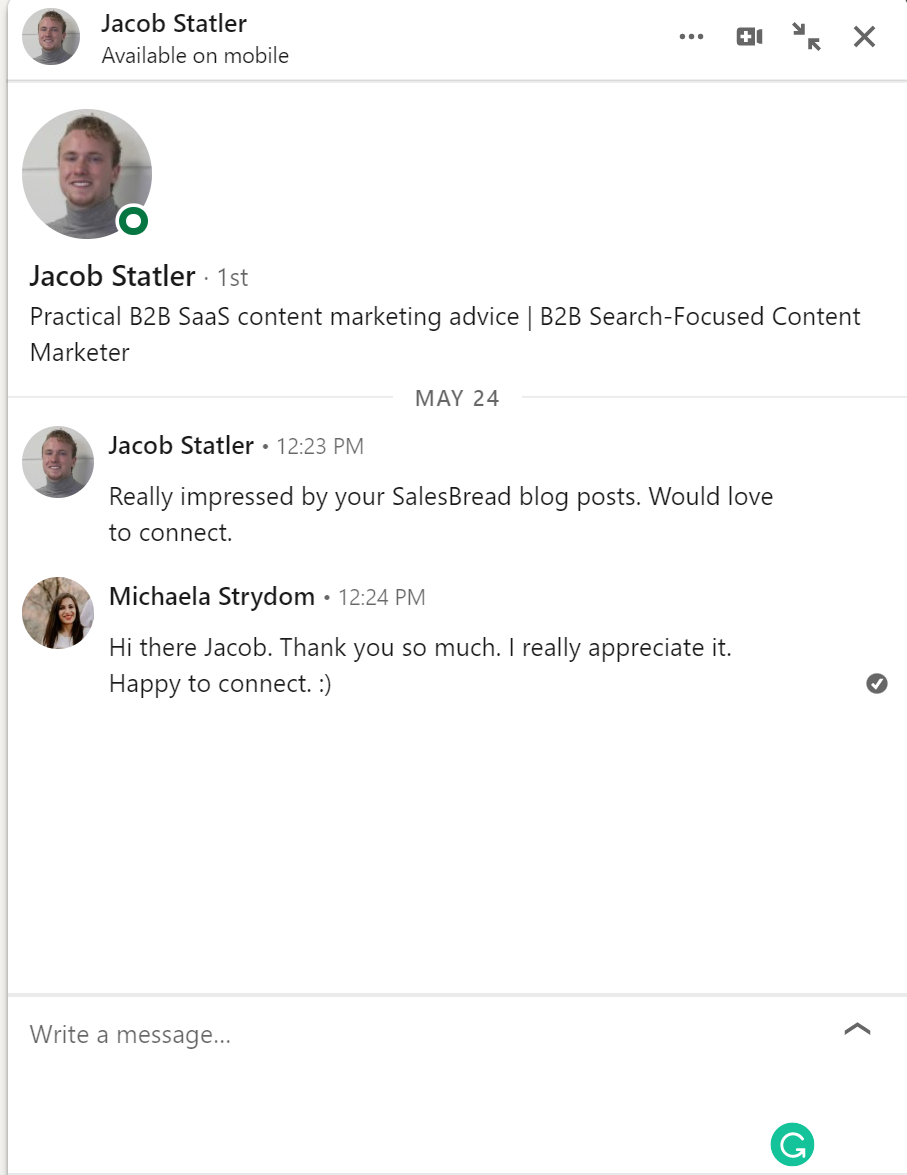
Can you see the difference? Which person would you reply to?
The compliment worked for me, and it made me realize that this is a real person behind the message, who has actually read some of my posts. So he did his research. He was someone that I didn’t mind engaging with.
And that’s the trick with Linkedin cold outreach –
It’s all about engaging and forming connections with the right people. It shouldn’t just be about selling. And how do you engage with prospects who are getting many many messages a day? You do this by researching them, to write a personalized message.
PRO TIP:
If you can’t find anything about the prospect in their “About Section” on Linkedin, Google their name, Google their business or check their other social media pages.
The chances of finding some piece of info to use for personalization will be out there, you just have to dig for it.
Step 2: Writing for connection requests
So now that you have researched your prospect you need to connect with them.
At Salesbread we suggest filtering your prospect list through your second-degree network first and by recently posted.
Why?
Because if someone is in your second-degree network, this tells us historically that they already accepted someone like you in the past into their network, so the chances of them accepting you, will be greater.
How should you write a connection request message?
At Salesbread we use a method called the CCQ method when it comes to copywriting.
This stands for:
- Commonalities
- Compliments
- Questions
Here are some personalized connection request message templates that you can adapt:
1. Hi (Name), I’m looking to expand my network with fellow business owners and professionals. I would love to learn about what you do and see if there’s any way we can support each other.
Cheers!
2. Hey (Name) Came across your profile and saw you work in real estate. I’m reaching out to connect with other like-minded people. Would be happy to make your acquaintance.
Have a good day!
3. Hi (Name) LinkedIn showed me your profile multiple times now, so I checked what you do. I really like your work and as we are both in the creative industry – I thought I’ll reach out. It’s always great to be connected with like-minded individuals, isn’t it?
(Your Name)
4. Hey (Name) I hope your week is off to a great start, I noticed we both work in the HR/Employee Experience field together. I would love to connect with you
5. (Name) My company has an idea for a book that would enhance your credibility and visibility. Is publishing a book on your radar? Do you have 15 minutes to talk this week?
6. (Name)I’m on a personal mission to grow my connections on LinkedIn, especially in the field of B2B lead & demand gen. I’d love to connect with you.
7. Great to meet a fellow podcast host. I am the host of (podcast name) and looking forward to having you as a guest on the show.
8. (Name), I wanted to reach out, as it seems like you would be the right person to discuss travel management given your role — although you may not be currently traveling, would you be interested in exploring how (company name) can help you prepare for the future of business travel? (Your name)
Some tips to remember when writing Linkedin connection requests
- Use personalization
- Keep “the universe” small by not asking for a lot. Keep it simple and to the point.
- Think about reciprocity. What will the reader gain if they connect with you? What value do you have to offer them?
- Be very clear about what you are doing and what you want from the prospect.
- Only send between 20-25 connection requests per day. This will ensure that you don’t burn through your prospect list and that Linkedin doesn’t suspend your account.
Step 3: Follow up messages
Follow-up messages are the next step in your outreach. Once a prospect connects with you, you should send them a follow-up message in real-time and ask for a meeting.
You will need to add more personalization in the follow-up section, and then have a strong call to action.
Here are some follow-up message examples:
1. (first name) good to connect, By the way, congrats on your new role at (company name.)
2. Good to connect (first name). By the way, what are your favorite hiking spots these days? Saw you’re in charge of account management, do you also handle clip reports (to keep clients updated?) Or am I way off?
3. {first_name}, good to connect. By the way, happy to give you an intro to anyone in my network now that we’re connected. I’ve been doing some research on (XYZ) (We provide (what your company does.)Since we’re newly connected, I’d like to share this post with you:(Share a link that’s helpful from your website.) P.S. It explains (XYZ)
4. Hi {first_name}, If you could help {company_name} with (XYZ) would that be worth a short conversation? I’m asking because of XYZ.
5. Thanks for connecting (first name). I’d love to connect outside of Linkedin too. Very curious to hear about where you get most of your (XYZ). What does your calendar look like over the next week or two to connect? PS: For background, my company does (XYZ).
6. Hi (first name) Thanks for connecting. We just opened our (discuss in short what your company does) I’d like to share some details about this opportunity with you. What’s your best email? (your name)
7. (first name) (Add a custom intro sentence)
My company is looking to invest in XYZ. Ps: For background, we have X + years in the industry. We have already purchased from companies such as XYZ
8. (First name) There is an upcoming webinar next month on XYZ. It’s invite-only and specifically for leaders in the (XYZ space). In fact, I’m sure you already know some executives in the group. What’s the best way to arrange a short conversation over the next few days?
Notice that the follow-ups are to the point and that you only need to mention very little about yourself for context. Most of the message is geared towards the prospects.
Do you notice how:
- Questions are asked?
- Commonalities are mentioned? (This creates common ground.)
- Compliments are made?
We continue with the CCQ method even in our follow-ups.
Do you also notice the strong CTAs? We always ask for a meeting or a quick phone call.
Some salespeople are nervous to ask for a call, but they shouldn’t be.
This also separates high-quality prospects who are really interested in your service, from those who aren’t.
Here are some strong CTA’s to use to get responses:
- Are you available for a chat?
- How is your availability for a 10 min call this week?
- I’d love to share more on why you may need [PRODUCT] and how it can help [BENEFIT].
- How’s {{=day}} next week look for a 15-minute call?
- Are you free for a call this Friday to discuss [MAIN BENEFIT]?
- Are you available for a quick call in the next few days to see if [MY PRODUCT] aligns with your goals?
- When are you free to connect this week? You can use this link to book directly on my calendar.
- Can we target {{=bday+2}} afternoon to discuss [BENEFIT/PROBLEM]?
- What’s the best way to schedule 5 minutes to talk?
- Would you have some time next {{=day}} to discuss?
- If you find the spec interesting, should we set up a confidential chat?
- Can we grab time Thursday afternoon to see if [MY COMPANY] aligns with your goals for this year?
- Are you available for a quick meeting to discuss your use case and see if we can assist in any way?
- Do you think it could help {{company. name}}? If so, happy to tell you how (here’s my calendar) or show you a demo.
Tips for follow-ups:
- Keep your messages short and to the point
- Add in more personalization
- If a prospect doesn’t reply after the first follow-up message, wait 3 days and send another follow-up. You can do this between 3 and 5 times, but wait 3 days between each follow-up.
Should you sell in your Linkedin cold messaging?
To answer this question, have a look at the message below:
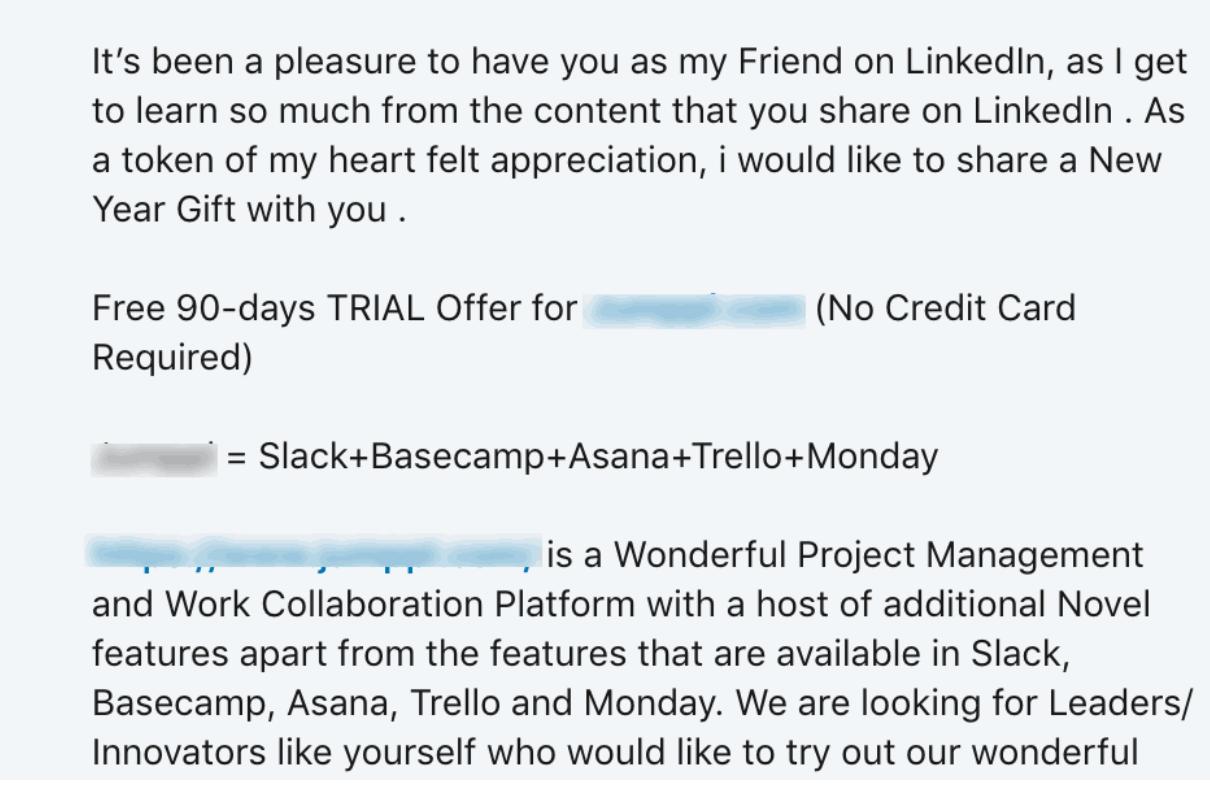
Would you respond to this message, after just accepting a connection request?
Most probably not.
(It’s like asking someone to marry you, without going on a few dates first.)
This salesperson hasn’t formed a connection yet with the prospect. They hopped right into the sale, which would make a Linkedin user less likely to respond.
At Salesbread we never sell in our Linkedin messages unless you have an excellent value prop, that the prospect would not say no to.
But in most cases, we ask for a meeting, and only sell the product or service in the call.
Remember the Golden Rule of outreach: “Talk about the prospect 90% of the time and only 10% about yourself, just to add context.”
Here is an example of how Salesbread would send a message:
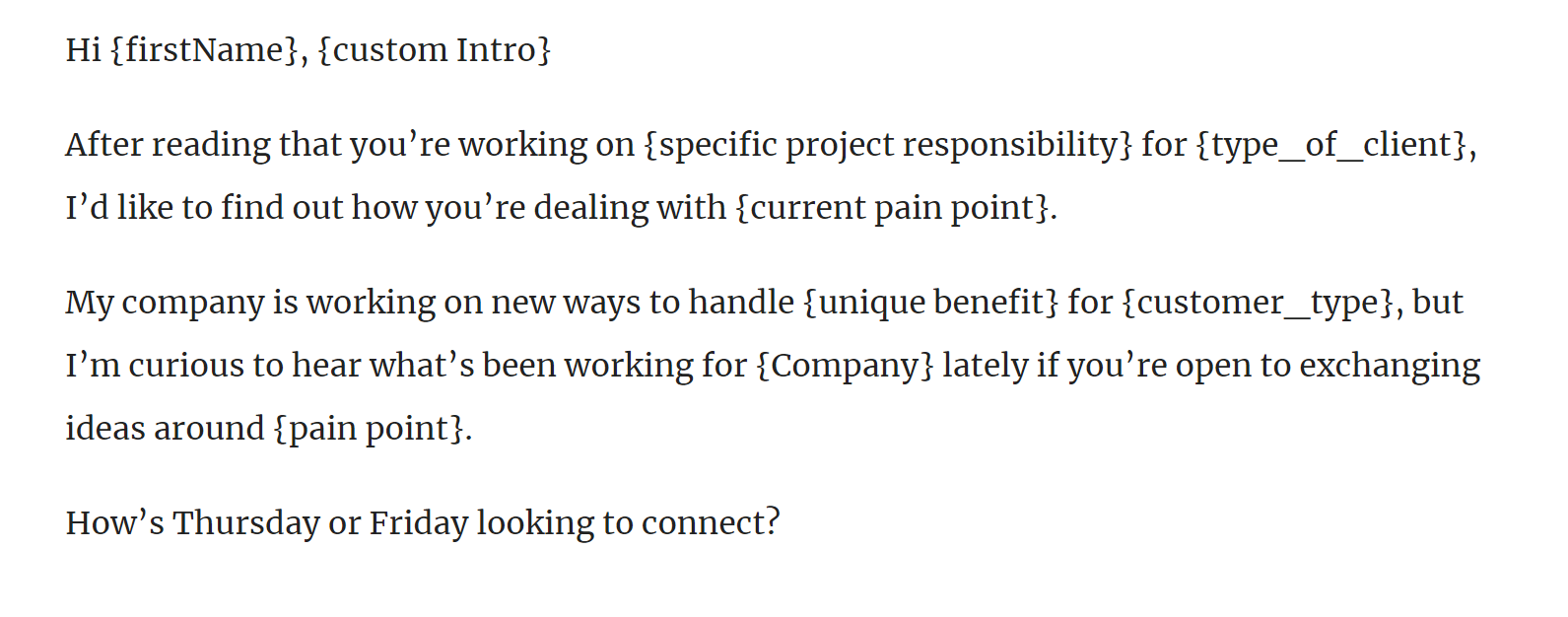
Do these kind of messages work?
Yes, here are some replies that we received:
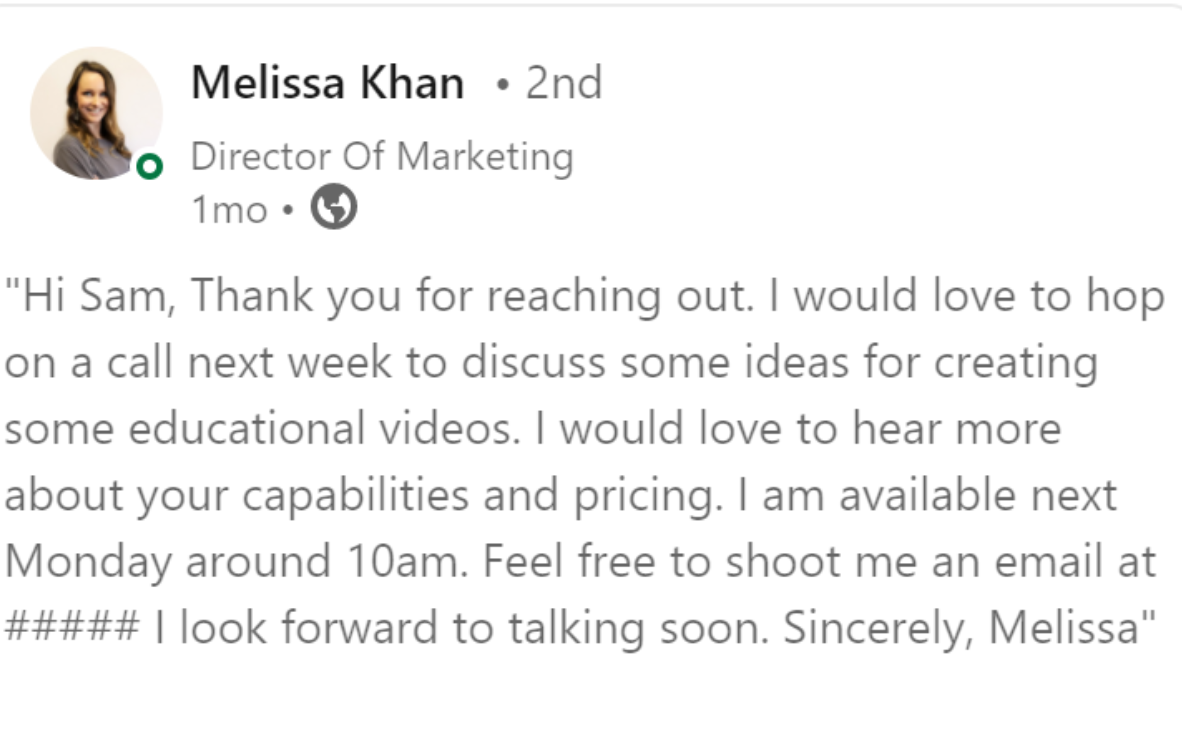
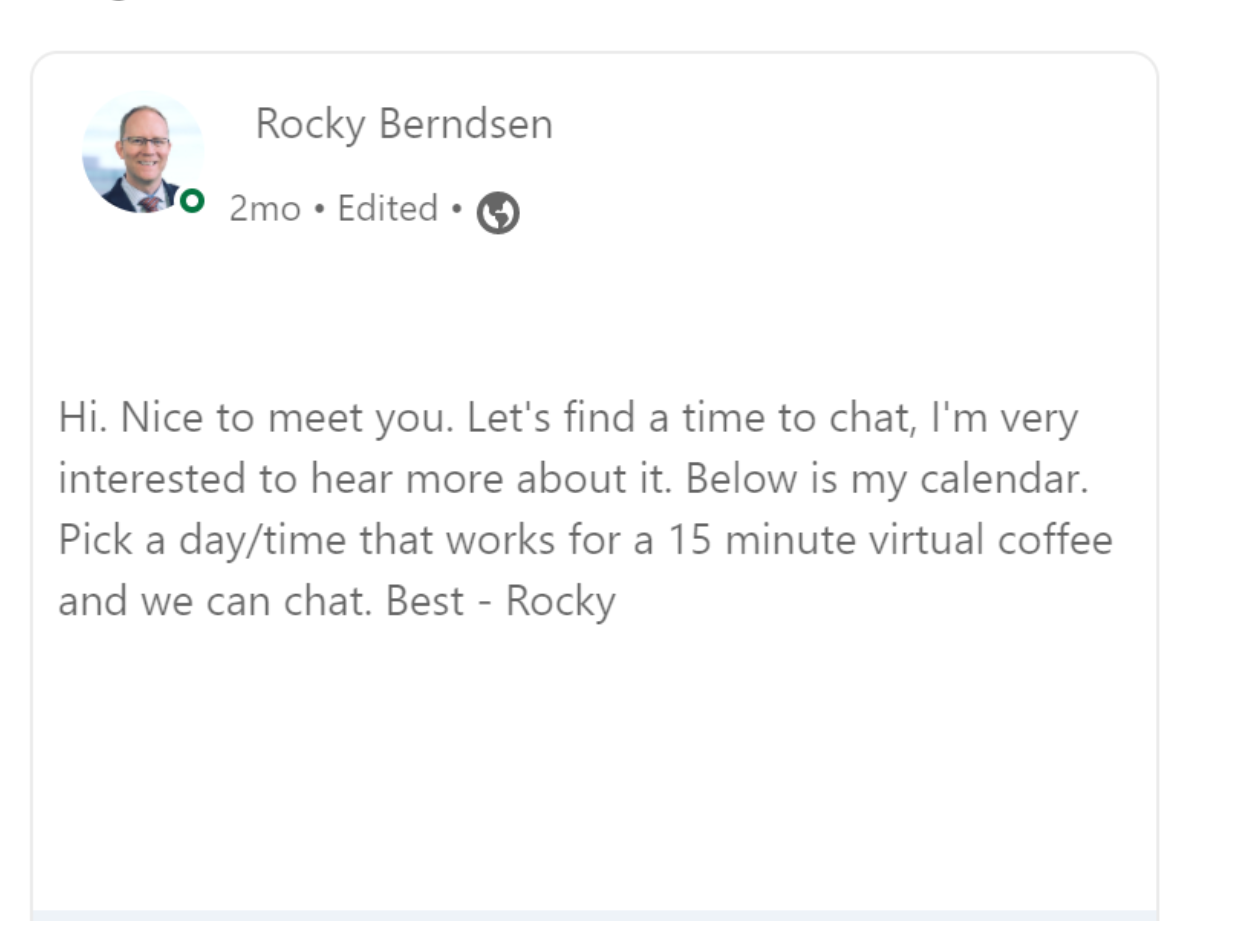
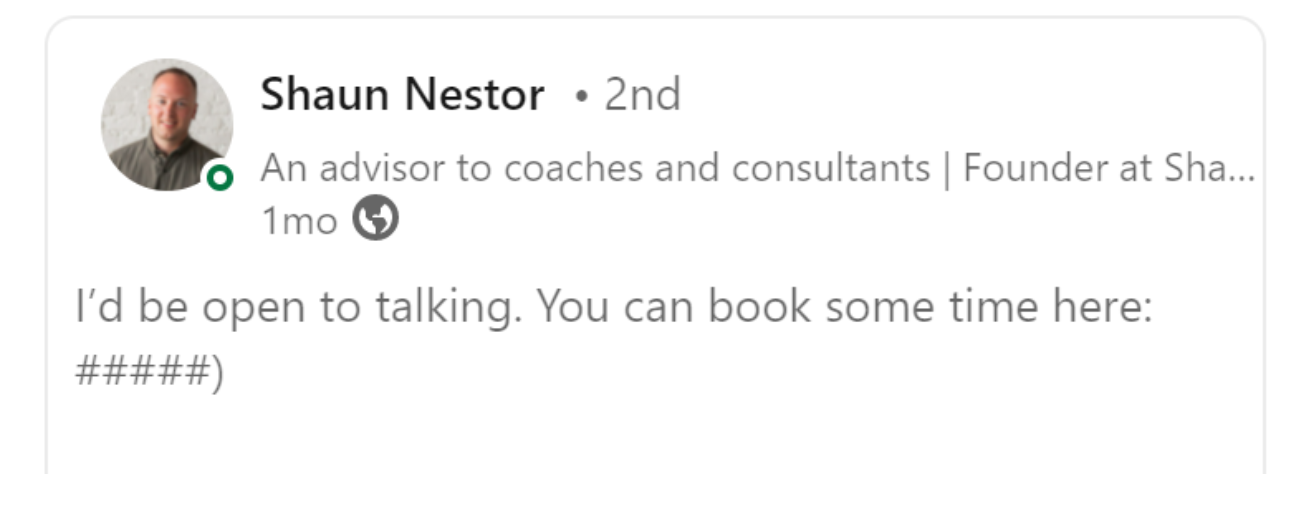
Ready to give these tips a try?
If you would like the same kind of replies from prospects and a reply rate of 39%, give these tips a try. It really works for us. Last year Salesbread generated close to 5000 qualified leads for our clients.
Or better yet, read this article :
https://salesbread.com/the-best-done-for-you-lead-generation-service/
to see what it would be like to partner up with Salesbread. In it, we explain what you can expect from us and why we differ from every other lead generation agency out there.
We guarantee 20+ qualified leads per day and we can promise this because of our data-driven approach to list building and our personalized outreach.
(If you aren’t yet ready to partner up with us, no worries, we also offer consultation services. Book your free 15 consultation call below.)
